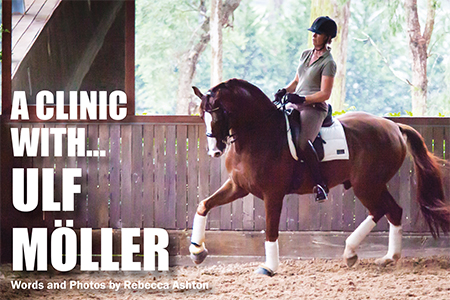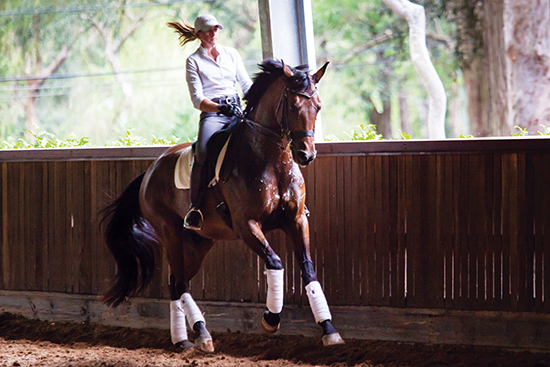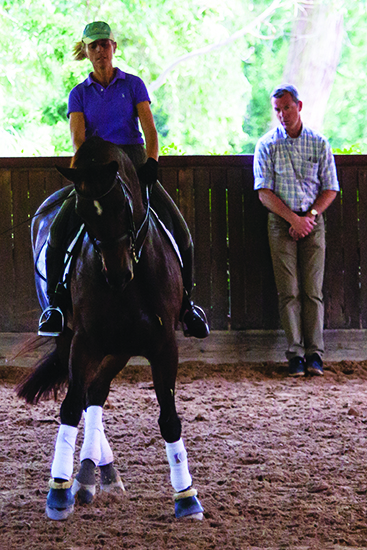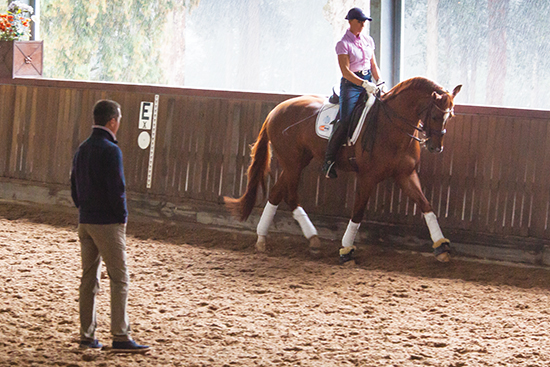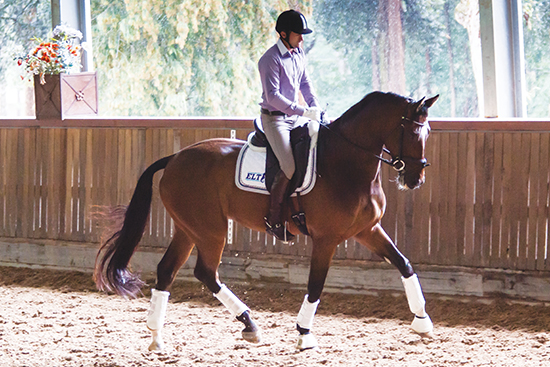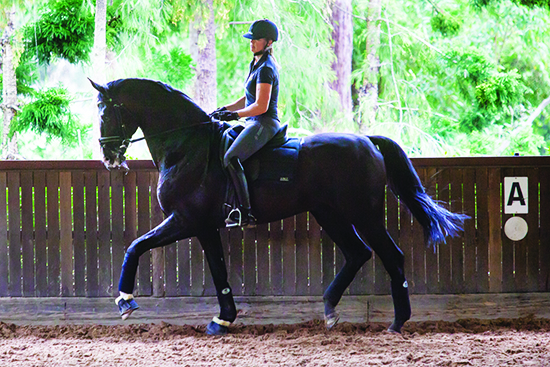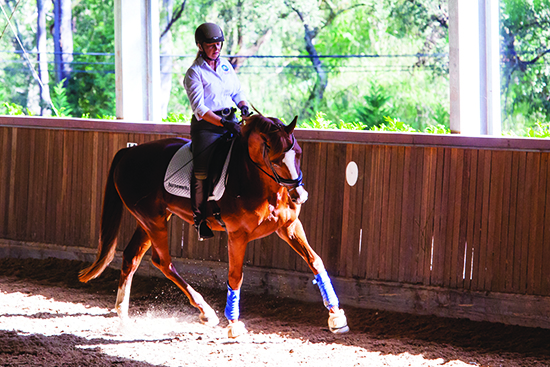At the Ulf Möller clinic held at Clemens and Judy Dierks’ gorgeous tree-nestled property in Arcadia, there were a string of top riders. But even though some Grand Prix horses participated, very few of the high level ‘tricks’ were seen. By his own admission, Herr Möller is not an expert at that level, but of course what is important to all levels is the basics and of this the German star certainly is a master.
When training with Ulf, very correct riding is insisted upon and nothing escapes the trainer’s eye. “I see everything,” I heard Ulf say to one student regarding a pre lesson warm up. He also really wanted the riders to understand why each exercise was being used at a particular point in time so that they became better equipped to solve their own problems when training alone.
The PSI based trainer wanted riders to be in the present moment, so problems could be corrected immediately but without too much force. He worked on consistency of the aids, correct contact and the perfect combination of hand, seat and leg as well as the correct execution of the exercises to develop the horse. Ulf spent a lot of time on the quality of the walk, horses need to lift up over their backs more and this was set as homework for most riders.
Developing true collection, even at the baby levels was emphasised. When the rider touches the bit, this isn’t an indication to the horse to back off and curl up behind the contact, but instead to adjust his position. The rider has to ride from behind to lighten the front end, not just open the reins forward. “The horse will never collect correctly from this. Push the back end up, touch the mouth and wait for the horse to find the way to soften.” Only then is the rider allowed to follow the horse a little with the hand. “You have to recognise the moment when the horse is correct and be light. You cannot miss this moment,” was his advice to Brett Peel.
Linda Foster and Neversfelde Samiro
Pupils were scared to have a good contact, and made it too light. Others balanced off the hand creating too strong a connection. Ulf was strict in this department. “Sometimes you need the contact a little heavy to start and then lighten it. But if you don’t have a correct contact, you cannot collect the horse.” If riders tried to get their horse’s neck in the correct position with wide hands, Ulf wasn’t encouraging, “Keep your hands close. This makes your position stronger.”
When younger horses played up due to the unfamiliar environment, Ulf didn’t let the riders back off the aids or contact. They had to keep the contact, keep the pressure on until the horse stopped its bad behaviour. It has to be comfortable for the horse to do the right thing. Megan Hewitt experienced this with her talented if slightly opinionated little mare. The exercise of forward, stop, wait and forward relaxed and focused the mare into doing the correct work without drama or a fight with Megan. Ulf didn’t mind mistakes and didn’t want riders correcting them too aggressively. “You don’t want the horse too scared to try and so alter its way of going,” he explained.
Most people who have had anything to do with Möller’s training know how highly he rates corners. He insists they be used, “I don’t know who made the short side of the arena 20 metres but this is what it is. Therefore make sure you don’t make it 10 metres by making your corners too big. Corner, straight, corner. Ride it like this,” Manu Josz was told.
The next step was serpentines. “Here you have corners, straight lines, corners, but more of them,” Ulf explained. Getting the straightness of the horse spot-on is important, but it has to be achieved from the legs, not the hands.
Deep corners are not achieved pulling the horse into the corner with the outside rein. “The inside leg is what takes the horse into the corner, but you can allow with the outside rein, or else it is not fair to the horse.”
Manu Josz and Waiiri
“Jump, jump, jump!” was heard in almost every lesson. Activity of the hindquarters had to be maintained, the old adage of collection is not slow was brought to the limelight. “First bring the horse back with your seat. Then, feel with the whip, don’t hit, feel it forward. Use the whip in the rhythm of the pace, rhythm is the most important thing.”
“Ride lines from the tests and you can even make up your own. Imagine if one day in the international book they had the Claire exercise!” The lure of international fame was used on Claire Seidl aboard her young stallion. The horses have to be kept interested in their work, to keep them from dozing off if they are that way inclined or to keep them focused if highly strung. Still test riding rates highly in Ulf’s teaching, “No test ever asks for a collected walk on the diagonal, so never do this. No test ever asks for a canter transition in the corner, so why do it?”
On to the more advanced horses. With movements of increased difficulty, such as half passes or pirouettes, Ulf wanted the riders to break things down a little and make it easier for the horses. Straight, then straight with flexion, then add the bend. “All of it at once can be too much for the horse at first.”
Judy Dierks and Ferramo
Gina Montgomery was worried about Rodrigo’s rhythm in passage, Ulf couldn’t see a problem but suggested to not make the rhythm too slow. The German also encouraged riders to get help if they needed. “I am not an expert in passage, so I get help. If your horse doesn’t understand the flying change for example, perhaps it is better to give the horse to a rider who is very good at this,” he advised. This is better for both horse and rider rather than getting into fights and confusing the horse.
Ulf commented a number of times on riders leaning too far back, especially in the canter, “If you lean back, you press the horse up against the bit and he cannot collect. Lean forward a little and to be sure you will feel him collect under you.” Elbows are to be at the side of the body so that there are no unintended movements of the hand, such as bringing it backwards and so the movement of the body can be felt through the reins to the bit. This makes riding quieter and more precise, but also means the rider needs very good control of their body. There has to be the perfect balance between relaxation and tension.”
Herr Möller is a committed and enthusiastic teacher. He’s not one of those ‘sit-in-the-corner-and-grunt’ types and rides every stride with his students. He was also generous in sharing ideas with the spectators. Often he would stop and point things out to the audience, asking the riders to do an exercise the wrong way and then the correct way so the spectators could see the difference. No one went home without knowledge and plenty of homework.
THE RIDERS’ PERSPECTIVE
Brett Peel
Brett, who is originally from the UK, is fairly new to this game of dressage. His background is breaking and training racehorses and this was the first clinic he had attended. He was aboard Lesley-Ann Taylor’s five-year-old, Skansen Park Wotan.
“Ulf was amazing. He could see straight away that the horse was tricky. He really got involved in the lesson and was able to click with the horse. That’s why he’s the person he is. He took us both further and we started to put the horse together.”
Wotan has a few connection issues and lots of personality, so the work was about getting the young gelding lower in front and over his back. When this improved, it was onto a bit of collection, sitting Wotan on his back end a little without any fight or hassle. Brett explained, “Ulf really got us there nicely. The horse has never really been collected before. He knew when to push the buttons and when not to.”
Brett had also started Linda Foster’s young four-year-old, “It was interesting to see him work with that horse as well. Both horses have very different personalities; the issue with my horse is trying to get the neck down and with Linda’s it is trying to get the neck up, but Ulf was successful with both.”
Gina Montgomery
Gina had a lesson on Maree Tomkinson’s Rodrigo, already known to Ulf as he spent time in his stable in Germany a few years ago. Gina rode the horse for a year. Gina also brought along David and Amanda Shoobridge’s imported stallion, Stedinger, and he came along to meet his fellow countryman as well.
“For me the lessons were about riding my boys straight and through to an even, consistent contact. This then enables us to ride for lateral bend, have the horse on the aids, responsive to the leg and to the half halts from which point we should be able to execute the “tricks”. We did a very interesting exercise with Stedi. Ulf asked me to ride the canter on a circle with extra inside bend so that the weight/load bearing came onto the inside front leg. I could feel the front end ‘burying’ but the canter rhythm held together still. Then Ulf had me go down the long side and take more weight in the outside rein and think of inside leg to outside rein and oh my goodness, we climbed into the clouds! The weight bearing shifted truly to the hind legs and the wither/shoulder lifted into orbit. It was a sensational feeling and for me was an obvious way to show the body mechanics and how important it is to ride the horse into the optimal balance so that it can perform to its maximum ability, something that Ulf does like a natural!”
“I must be sure not to over ride the stride in my desire for impulsion. I have to maintain a solid, consistent contact, carrying my hands forward and be very subtle with the contact, particularly with the stallion. If he gets distracted looking at something, I must not overreact with the hand to bring him back to the bit. The horse has to be confident with the bit, always happy to take contact forward because without this how can we ever achieve true thoroughness? This is something I have in my mind each day, but now I hear it in Ulf’s accent!”
Claire Seidl
Claire is a seasoned campaigner and has trained in Germany. Now a successful breeder of young horses, she brought a couple of her young stars; her super cute four-year-old stallion Wicked and leggy five-year-old World Magic.
“Although nothing phases him, Wincy (World Magic) has endless energy and he’s so big that he can be hard to turn! What is so good is that Ulf is so strict. I think we lack that in Australia. You have to ride the corner or diagonal correctly. You have to ride every moment and every movement. Having said that, he is also fun. He’s a very good communicator and can make you laugh but also makes you look outside the square for answers.”

